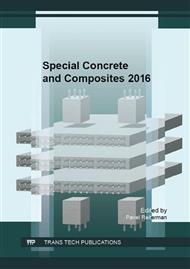[1]
B. Zając, I. Gołębiowska, Construction waste management. Inżynieria i Aparatura Chemiczna, 53, 6 (2014) 393-395, (in Polish).
Google Scholar
[2]
H. Wen, D.I. McLean, K. Willoughby, Evaluation of recycled concrete as aggregates in new concrete pavements. Transportation Research Record, Journal of the Transportation Research Board, 2508 (2015) 73-78.
DOI: 10.3141/2508-09
Google Scholar
[3]
F. Pacheco-Torgal, V. Tam, J. Labrincha, Y. Ding, J. de Brito. Handbook of recycled concrete and demolition waste, Elsevier, (2013).
DOI: 10.1533/9780857096906
Google Scholar
[4]
A. Golda, A. Król, Second life of concrete. Budownictwo, Technologie, Architektura, 4 (2006) 44–47, (in Polish).
Google Scholar
[5]
W. Kozioł, P. Kawalec, Alternative aggregate in building. Nowoczesne Budownictwo Inżynieryjne, 4 (2008) 34–37, (in Polish).
Google Scholar
[6]
RILEM TC 121-DRG. Specifications for concrete with recycled aggregates, (1994).
Google Scholar
[7]
M.N. Fardis. Innovative materials and techniques in concrete construction, Springer, (2012).
Google Scholar
[8]
W. Kubissa, R. Jaskulski, A. Koper, M. Supera. High performance concrete with SCM and recycled aggregate. Key Engineering Materials, 677 (2016) 233-240.
DOI: 10.4028/www.scientific.net/kem.677.233
Google Scholar
[9]
A. Koper, M. Koper, W. Kubissa, Determining concrete composition on recycled aggregates. Key Engineering Materials, 677 (2016) 266-272.
DOI: 10.4028/www.scientific.net/kem.677.266
Google Scholar
[10]
A. Ajdukiewicz. Aspects of durability and impact on environment in design of concrete structures, Przegląd Budowlany, 82, 2 (2011) 20-29, (in Polish).
Google Scholar
[11]
L. Taerwe, S. Matthys, et al., Fib model code for concrete structures 2010, Ernst & Sohn, Wiley, (2013).
Google Scholar
[12]
C.G. Nogueira, E.D. Leonel, Probabilistic models applied to safety assessment of reinforced concrete structures subjected to chloride ingress. Engineering Failure Analysis, 31 (2013) 76-89.
DOI: 10.1016/j.engfailanal.2013.01.023
Google Scholar
[13]
H.S. Müller, I. Anders, R. Breiner, M. Vogel, Concrete: treatment of types and properties in fib model code 2010, Structural Concrete, 14, 4 (2014) 320-334.
DOI: 10.1002/suco.201200048
Google Scholar
[14]
P. Lovato, E. Possan, D. Dal Molin, A. Masuero, J. Ribeiro, Modeling of mechanical properties and durability of recycled aggregate concretes, Constr. Build. Mater. 26 (2012) 437-447.
DOI: 10.1016/j.conbuildmat.2018.09.018
Google Scholar
[15]
Z.P. Bažant, M.F. Kaplan, Concrete at high temperatures: material properties and mathematical models, Longman, (1996).
Google Scholar
[16]
R. Jaskulski, Application of simulation methods in engineering issues, Zeszyty Naukowe. Budownictwo/Politechnika Śląska 93 (2001) 165-174, (in Polish).
Google Scholar


